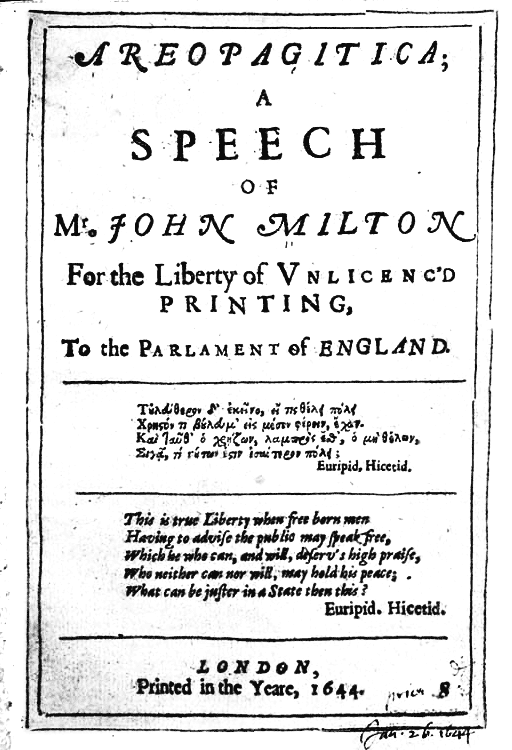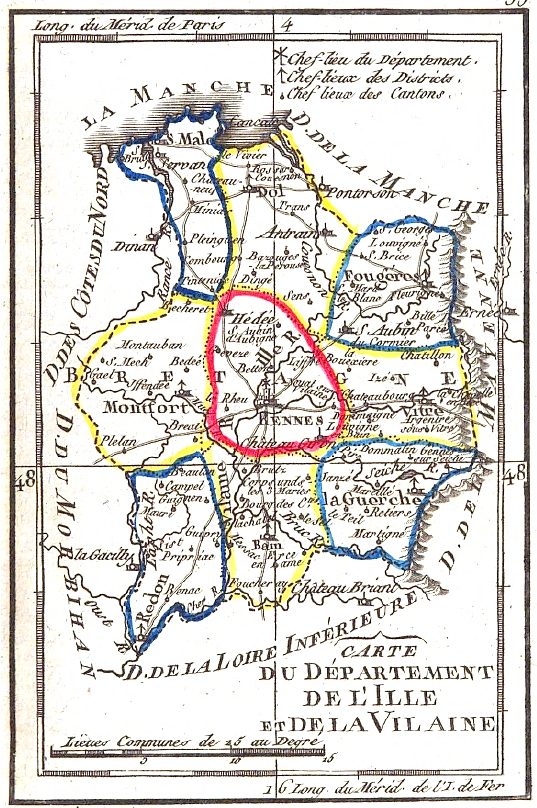|
Mirari Vos
(Latin: "That you wonder"; subtitled "On Liberalism and Religious Indifferentism"), sometimes referred to as , was the fourth encyclical letter of Pope Gregory XVI and was issued in August 1832. Addressed to "All Patriarchs, Primates, Archbishops, and Bishops of the Catholic World", it is general in its audience and scope, whereas his three earlier encyclicals had been addressed to more specific audiences in the Papal States and the Kingdom of Poland. Background Felicité de Lamennais, Charles de Montalembert and Henri Lacordaire had started a newspaper, L'Avenir ("The Future") in October 1830. While the paper was a strong proponent of ultramontanism, supporting the authority of the papacy in opposition to nationalist and secularist ideas, it also advocated an enlarged suffrage, separation of church and state, and universal freedom of conscience, instruction, assembly, and the press. Its editors saw no conflict between Catholicism and liberal reform. The conservative F ... [...More Info...] [...Related Items...] OR: [Wikipedia] [Google] [Baidu] |
Liberalism
Liberalism is a Political philosophy, political and moral philosophy based on the Individual rights, rights of the individual, liberty, consent of the governed, political equality, the right to private property, and equality before the law. Liberals espouse various and often mutually conflicting views depending on their understanding of these principles but generally support private property, market economies, individual rights (including civil rights and human rights), liberal democracy, secularism, rule of law, Economic freedom, economic and political freedom, freedom of speech, freedom of the press, freedom of assembly, and freedom of religion.Generally support: * * * * * * *constitutional government and privacy rights * Liberalism is frequently cited as the dominant ideology of modern history.Wolfe, p. 23. Liberalism became a distinct Political movement, movement in the Age of Enlightenment, gaining popularity among Western world, Western philosophers and economists. L ... [...More Info...] [...Related Items...] OR: [Wikipedia] [Google] [Baidu] |
Freedom Of Conscience
Freedom of conscience is the freedom of an individual to act upon their moral beliefs. In particular, it often refers to the freedom to ''not do'' something one is normally obliged, ordered or expected to do. An individual exercising this freedom may be called a ''conscientious objector''. The right to freedom of conscience is recognized by several international conventions, such as the Universal Declaration of Human Rights and the European Convention on Human Rights. It is distinct from but closely related to freedom of thought, freedom of expression and freedom of religion. See also * Artistic freedom * Autonomy * Cognitive liberty * Conscience clause (education) * Conscience clause in medicine in the United States * Conscientious objection to abortion * Conscientious objection to military service * Freethought * Intellectual freedom * Liberty * Political freedom * Prisoner of conscience * Vaccine hesitancy and religion * Vegan school meal * Whistleblowing Whistleblow ... [...More Info...] [...Related Items...] OR: [Wikipedia] [Google] [Baidu] |
Bishop Of Rennes
The Archdiocese of Rennes, Dol, and Saint-Malo (Latin: ''Archidioecesis Rhedonensis, Dolensis et Sancti Maclovii''; French: ''Archidiocèse de Rennes, Dol et Saint-Malo''; ) is a Latin Church diocese of the Catholic Church in France. The diocese is coextensive with the department of Ille et Vilaine. The Archdiocese has 8 suffragans: the Diocese of Angers, the Diocese of Laval, the Diocese of Le Mans, the Diocese of Luçon, the Diocese of Nantes, the Diocese of Quimper and Léon, the Diocese of Saint-Brieuc and Tréguier, and the Diocese of Vannes. The Concordat of 1802 re-established the Diocese of Rennes which since then has included: the ancient Diocese of Rennes with the exception of three parishes given to the Diocese of Nantes"> ... re-established the Diocese of Rennes which since then has included: the ancient Diocese of Rennes with the exception of three parishes given to the Diocese of Nantes; the greater part of the ancient Diocese of Dol; the greater part of ... [...More Info...] [...Related Items...] OR: [Wikipedia] [Google] [Baidu] |
Paederasty
Pederasty or paederasty () is a sexual relationship between an adult man and an adolescent boy. It was a socially acknowledged practice in Ancient Greece and Rome and elsewhere in the world, such as Pre-Meiji Japan. In most countries today, the local age of consent determines whether a person is considered legally competent to consent to sexual acts, and whether such contact is child sexual abuse or statutory rape. An adult engaging in sexual activity with a minor is considered abusive by authorities for a variety of reasons, including the age of the minor and the psychological and physical harm they may endure. Etymology and usage ''Pederasty'' derives from the combination of with (cf. ''eros''). Late Latin ''pæderasta'' was borrowed in the 16th century directly from Plato's classical Greek in ''The Symposium.'' (Latin transliterates ' as ''æ''.) The word first appeared in the English language during the Renaissance, as ''pæderastie'' (e.g. in Samuel Purchas' ''Pilgr ... [...More Info...] [...Related Items...] OR: [Wikipedia] [Google] [Baidu] |
Owen Chadwick
William Owen Chadwick (20 May 1916 – 17 July 2015) was a British Anglican priest, academic, rugby international,Owen Chadwick rugby profile ESPN Scrum.com writer and prominent historian of Christianity. As a leading academic, Chadwick became Dixie Professor of Ecclesiastical History in 1958, serving until 1968, and from 1968 to 1983 was Regius Professor of History. Chadwick was elected master of |
Canon Law Of The Catholic Church
The canon law of the Catholic Church () is "how the Church organizes and governs herself". It is the system of religious laws and canon law, ecclesiastical legal principles made and enforced by the Hierarchy of the Catholic Church, hierarchical authorities of the Catholic Church to regulate its external organization and government and to order and direct the activities of Catholics toward the mission of the Church. It was the first modern Western world, Western legal system and is the oldest continuously functioning legal system in the West, while the unique traditions of Eastern Catholic canon law govern the 23 Eastern Catholic Churches, Eastern Catholic particular churches '. Positive ecclesiastical laws, based directly or indirectly upon immutable divine law or natural law, derive formal authority in the case of universal laws from Promulgation (Catholic canon law), promulgation by the supreme legislator—the supreme pontiff, who possesses the totality of legislative, executi ... [...More Info...] [...Related Items...] OR: [Wikipedia] [Google] [Baidu] |
Clerical Celibacy In The Catholic Church
Clerical celibacy is the discipline within the Roman Catholic Church by which only unmarried men are ordained to the episcopate, to the priesthood in the Latin Church (one of the 24 rites of the Catholic Church with some particular exception and in some autonomous particular Churches), and similarly to the diaconate. In other autonomous particular churches, the discipline applies only to the episcopate. According to Jason Berry of ''The New York Times'', "The requirement of celibacy is not dogma; it is an ecclesiastical law that was adopted in the Middle Ages because Rome was worried that clerics' children would inherit church property and create dynasties." For several hundred years after the imposition of celibacy on secular (non-monastic/religious) clergy the sale of church offices continued (known as the sin of Simony). The first male issue of non-married concubines of celibate clergy became set to continue the dynasty (a form of nepotism). To curtail this clerical abuse, ... [...More Info...] [...Related Items...] OR: [Wikipedia] [Google] [Baidu] |
Married Clergy
Clerical marriage is the practice of allowing Christian clergy (those who have already been ordained) to marry. This practice is distinct from allowing married persons to become clergy. Clerical marriage is admitted among Protestants, including both Lutherans and Anglicans. Many Eastern Churches (Assyrian Church of the East, Eastern Orthodox, Oriental Orthodox, or Eastern Catholic), while allowing married men to be ordained, do not allow clerical marriage after ordination: their parish priests are often married, but must marry before being ordained to the priesthood. Eastern Lutheran clergy are permitted to marry after being ordained, and married Eastern Lutherans are eligible to become clergy. Within the lands of the Eastern Christendom, priests' children often became priests and married within their social group, establishing a tightly knit hereditary caste among some Eastern Christian communities. The Latin Catholic Church as a rule requires clerical celibacy for the priest ... [...More Info...] [...Related Items...] OR: [Wikipedia] [Google] [Baidu] |
Traditi Humilitati
''Traditi humilitati'' is a papal encyclical issued by Pope Pius VIII in 1829. It laid out the program for his pontificate. Although it does not explicitly mention freemasonry, it has been cited by later Church documents on the subject because it condemned those "who think that the portal of eternal salvation opens for all from any religion". Regarding religious pluralism, Pius VIII condemned the "foul contrivance of the sophists of this age" that would place Catholicism on a par with any other religion. Regarding Bible translations and the work of non-Catholic bible societies, he wrote: On marriage, ''Traditi humilitati'' fell within a series of papal documents "denying that the civil power can regulate marriage", which can be traced from a letter of Pope Pius VII to the Archbishop of Mainz, ''Etsi Fraternitatis'', sent on 8 October 1803, stating that lay tribunals' and non-Catholic assemblies' declarations of nullity and attempts to dissolve marriages "have no value or eff ... [...More Info...] [...Related Items...] OR: [Wikipedia] [Google] [Baidu] |
Pius VIII
Pope Pius VIII (; born Francesco Saverio Maria Felice Castiglioni; 20 November 1761 – 30 November 1830) was head of the Catholic Church and ruler of the Papal States from 31 March 1829 to his death in November 1830. Pius VIII's pontificate was the shortest of the 19th century, and is likely the least remembered. His brief papacy witnessed the Catholic Emancipation in the United Kingdom in 1829, which he welcomed, and the July Revolution in France in 1830, which he accepted with reluctance. Pius VIII is often remembered for his writings on marriages between Catholics and Protestants: in the 1830 brief ''Litteris altero abhinc'', he declared that a marriage could only be properly blessed if proper provisions had been made to ensure the bringing up of children in the Catholic faith. His death, less than two years after his election to the papacy, has led to speculation of a possible murder. Early life Francesco Saverio Castiglioni was born in Cingoli, Marche, the third of eight ... [...More Info...] [...Related Items...] OR: [Wikipedia] [Google] [Baidu] |
Leo XII
Pope Leo XII (; born Annibale Francesco Clemente Melchiorre Girolamo Nicola della Genga; 2 August 1760 – 10 February 1829) was head of the Catholic Church and ruler of the Papal States from 28 September 1823 to his death in February 1829. Leo XII was in ill health from the time of his election to the papacy to his death less than 6 years later, though he was noted for enduring pain well. He was a deeply conservative ruler, who enforced many controversial laws, including one forbidding Jews to own property. Though he raised taxes, the Papal States remained financially poor. Biography Family Della Genga was born in 1760 at the Castello della Genga in the territory of Fabriano to an old noble family from Genga, a small town in the March of Ancona, part of the Papal States. He was the sixth of ten children born to Count Ilario della Genga and Maria Luisa Periberti di Fabriano, and he was the uncle of Gabriele della Genga Sermattei, who in the 19th century was the only neph ... [...More Info...] [...Related Items...] OR: [Wikipedia] [Google] [Baidu] |







